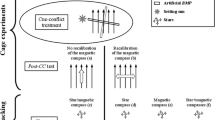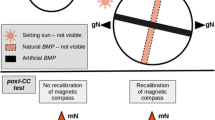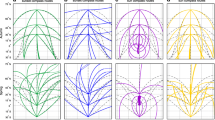Abstract
Hierarchical relationships among different compass systems in long-distance migrants are still a matter for discussion because different studies have led to highly variable and apparently contradictory results. We carried out cue-conflict experiments during spring migration on pied flycatchers Ficedula hypoleuca (Passeriformes, Muscicapidae). Birds were exposed to a conflict between celestial and magnetic information by altering the polarized light pattern or magnetic field. The polarization pattern was shifted (±90°) with filters, whereas the magnetic field was altered (+90°) through Helmholtz coils. Birds were tested in modified Emlen funnels both before and after the cue conflict; during the tests, only the natural magnetic field was available. This protocol was designed to test whether the experimental birds recalibrated their magnetic compass on the directional information derived from the light polarization pattern when the region near the horizon was visible during the conflict. Contrary to this expectation, we did not record any significant shift in magnetic orientation after one or repeated exposures to the cue conflict. Our results support earlier studies, which suggest that the magnetic field is the primary compass cue during the migratory period.






Similar content being viewed by others
References
Able KP, Able MA (1990) Ontogeny of migratory orientation in the Savannah sparrow, Passerculus sandwichensis: calibration of the magnetic compass. Anim Behav 39:905–913
Able KP, Able MA (1993) Daytime calibration of magnetic orientation in a migratory bird requires a view of skylight polarization. Nature 364:523–525
Able KP, Able MA (1995) Interactions in the flexible orientation system of a migratory bird. Nature 375:230–232
Adams DC, Anthony CD (1996) Using randomisation techniques to analyse behavioural data. Anim Behav 51:733–738
Åkesson S (1993) Effect of geomagnetic field on orientation of the marsh warbler Acrocephalus palustris, in Sweden and Kenya. Anim Behav 46:1157–1167
Åkesson S (1994) Comparative orientation experiments with different species of passerine long-distance migrants: effect of magnetic field manipulation. Anim Behav 48:1379–1393
Åkesson S (1999) Do passerine migrants captured at an inland site perform temporary reverse migration in autumn? Ardea 87:129–137
Åkesson S, Ottosson U, Sandberg R (1995) Bird orientation: displacement experiments with young autumn migrating wheatears, Oenanthe oenanthe, along the arctic coast of Russia. Proc R Soc Lond B 262:189–195
Alerstam T (1990) Bird migration. Cambridge University Press, Cambridge
Alerstam T, Högstedt G (1983) The role of the geomagnetic field in the development of birds' compass sense. Nature 306:463–465
Batschelet E (1981) Circular statistics in biology. Academic, London
Bingman VP (1984) Night sky orientation of migratory pied flycatcher raised in different magnetic fields. Behav Ecol Sociobiol 15:77–80
Bingman VP (1987) Earth's magnetism and the nocturnal orientation of migratory European robins. Auk 104:523–525
Bingman VP, Wiltschko W (1988) Orientation of dunnocks (Prunella modularis) at sunset. Ethology 77:1–9
Brines M, Gould J (1982) Skylight polarization patterns and animal orientation. J Exp Biol 96:69–91
Carere C, Welink D, Drent PJ, Koolhass JM, Groothuis AGG (2001) Effect of social defeat in a territorial bird (Parus major) selected for different coping styles. Physiol Behav 73:427–433
Cherry JD, Able KP (1986) An alternative method for the analysis of Emlen funnel data. Auk 103:225–227
Cochran WW, Mouritsen H, Wikelski M (2004) Migrating songbirds recalibrate their magnetic compass daily from twilight cues. Science 304:405–408
De Santis A, Gaya-Piqué L, Dominici G, Meloni A, Torta JM, Tozzi R (2003) ITalian Geomagnetic Reference Field (ITGRF): update for 2000 and secular variation model up to 2005 by autoregressive forecasting. Ann Geophys 46:491–500
Drent PJ, Marchetti C (1999) Individuality, exploration and foraging in hand raised juvenile great tits. In: Adams NJ, Slotow RH (eds) Proc 22 Int Ornithol Congr, Durban. BirdLife South Africa, Johannesburg, pp 896–914
Emlen ST, Emlen JT (1966) A technique for recording migratory orientation of captive birds. Auk 83:361–367
Giunchi D, Baldaccini NE (2004) Orientation of juvenile barn swallows (Hirundo rustica) tested in Emlen funnels during autumn migration. Behav Ecol Sociobiol 56:124–131
Giunchi D, Baldaccini NE (2006) Orientation experiments with displaced juvenile barn swallows (Hirundo rustica) during autumn migratory season. Behav Ecol Sociobiol 59:624–633
Holberton RL (1999) Changes in patterns of corticosterone secretion concurrent with migratory fattening in a Neotropical migratory bird. Gen Comp Endocrinol 116:49–58
Horváth G, Varjú D (2004) Polarized light in animal vision: polarization patterns in nature. Springer, Berlin
Kaiser A (1993) A new multi-category classification of subcutaneous fat deposits on songbirds. J Field Ornithol 64:246–355
Komenda-Zehnder S, Liechti F, Bruderer B (2002) Is reverse migration a common feature of nocturnal bird migration? An analysis of radar data from Israel. Ardea 90:325–334
Lundberg A, Alatalo RV (1992) The pied flycatcher. Poyser, London
Marchetti C, Baldaccini NE (2003) Individual variability in experiments with Emlen funnels. In: Berthold P, Gwinner E, Sonnenschein E (eds) Avian migration. Springer, Berlin, pp 393–405
Marchetti C, Drent PJ (2000) Individual differences in the use of social information in foraging by captive great tits. Anim Behav 60:131–140
Marchetti C, Zehtindjiev P (2009) Migratory orientation of sedge warblers (Acrocephalus schoenobaenus) in relation to eating and exploratory behaviour. Behav Proc 82:293–300
Marchetti C, Bezzi EM, Baldaccini NE (1998) Orientation in relation to exposure to the setting sun in some passerine trans-Saharan migrants. Ethol Ecol Evol 10:143–157
Moore BR (1980) A modification of the Rayleigh test for vector data. Biometrika 67:175–180
Moore FR (1987) Sunset and the orientation behaviour of migrating birds. Biol Rev 62:65–86
Moore FR, Phillips JB (1988) Sunset, skylight polarization and the migratory orientation of yellow-rumped warblers (Dendroica coronata). Anim Behav 36:1770–1778
Mouritsen H (1998) How do young night migrating passerines use their compasses for orientation during migration? Proc 22 Int Ornithol Congr, Durban. Ostrich 69:54
Muheim R, Jenni L (1999) Nocturnal orientation of robins, Erithacus rubecula: birds caught during migratory flight are disoriented. Acta Ethol 2:43–50
Muheim R, Jenni L, Weindler P (1999) The orientation behaviour of chaffinches, Fringilla coelebs, caught during active migratory flight, in relation to the sun. Ethology 105:97–110
Muheim R, Moore FR, Phillips JB (2006a) Calibration of magnetic and celestial compass cues in migratory birds—a review of cue conflict experiments. J Exp Biol 209:2–17
Muheim R, Phillips JB, Åkesson S (2006b) Polarized light cues underlie compass cue integration in migratory songbirds. Science 313:837–839
Muheim R, Akesson S, Phillips JB (2007) Magnetic compass of migratory Savannah Sparrows is calibrated by skylight polarization at sunrise and sunset. J Ornithol 148(Suppl 2):S485–S494
Muheim R, Akesson S, Phillips JB (2008) Response to R. Wiltschko et al. (J.Ornithol.): contradictory results on the role of polarized light in compass calibration in migratory songbirds. J Ornithol 149:659–662
Pilastro A, Macchio S, Massi A, Montemaggiori A, Spina F (1998) Spring migratory routes of eight trans-Saharan passerines through the central and western Mediterranean; results from a network of insular and coastal ringing sites. Ibis 140:591–598
Prinz K, Wiltschko W (1992) Migratory orientation of pied flycatchers: interaction of stellar and magnetic information during ontogeny. Anim Behav 44:539–545
Sandberg R (2003) Stored fat and migratory orientation. In: Berthold P, Gwinner E, Sonnenschein E (eds) Avian migration. Springer, Berlin, pp 515–525
Sandberg R, Pettersson J, Alerstam T (1988a) Shifted magnetic fields lead to deflected and axial orientation of migrating robins, Erithacus rubecula, at sunset. Anim Behav 36:877–887
Sandberg R, Pettersson J, Alerstam T (1988b) Why do migrating robins, Erithacus rubecula, captured at two nearby stop-over sites orient differently? Anim Behav 36:865–876
Sandberg R, Pettersson J, Persson K (1991) Migratory orientation in free-flying robins Erithacus rubecula and pied flycatchers Ficedula hypoleuca: release experiments. Ornis Scand 22:1–11
Sandberg R, Bäckman J, Moore FR, Lõhmus M (2000) Magnetic information calibrates celestial cues during migration. Anim Behav 60:453–462
Sandberg R, Moore FR, Bäckman J, Löhmus M (2002) Orientation of nocturnally migrating Swainson's thrush at dawn and dusk: importance of energetic condition and geomagnetic cues. Auk 119:201–209
Spina F, Volponi S (2008) Atlante della Migrazione degli Uccelli in Italia. 2. Passeriformi. Ministero dell'Ambiente e della Tutela del Territorio e del Mare, Istituto Superiore per la Protezione e la Ricerca Ambientale (ISPRA), Roma
Verbeek MEM, Drent PJ, Wiepkema PR (1994) Consistent individual differences in early exploratory behaviour of male great tits. Anim Behav 48:1113–1121
Weindler P, Liepa V (1999) The influence of premigratory experience on the migratory orientation of birds. In: Adams NJ, Slotow RH (eds) Proc 22 Int Ornithol Congr, Durban. BirdLife South Africa, Johannesburg, pp 979–987
Wiltschko R, Wiltschko W (1995) Magnetic orientation in animals. Springer, Berlin
Wiltschko R, Wiltschko W (1999) Celestial and magnetic cues in experimental conflict. In: Adams NJ, Slotow RH (eds) Proc 22 Int Ornithol Congr, Durban. BirdLife South Africa, Johannesburg, pp 988–1004
Wiltschko R, Wiltschko W (2003) Mechanisms of orientation and navigation in migratory birds. In: Berthold P, Gwinner E, Sonnenschein E (eds) Avian Migration. Springer, Berlin, pp 433–456
Wiltschko R, Munro U, Ford H, Wiltschko W (1999) After-effects of exposure to conflicting celestial and magnetic cues at sunset in migratory silvereyes, Zosterops l. lateralis. J Avian Biol 30:56–62
Wiltschko R, Munro U, Ford H, Wiltschko W (2001) Orientation in migratory birds: time associated relearning of celestial cues. Anim Behav 62:245–250
Wiltschko R, Munro U, Ford H, Wiltschko W (2008a) Contradictory results on the role of polarized light in compass calibration in migratory songbirds. J Ornithol 149:607–614
Wiltschko R, Munro U, Ford H, Wiltschko W (2008b) Response to the comments by R. Muheim, S. Åkesson, and J.B. Phillips to our paper “Contradictory results on the role of polarized light in compass calibration in migratory songbirds”. J Ornithol 149:663–664
Wiltschko W, Wiltschko R (1975a) The integration of stars and magnetic field in the orientation system of night migrating birds. I. Autumn experiments with European warblers (Gen. Sylvia). Z Tierpsychol 37:337–355
Wiltschko W, Wiltschko R (1975b) The integration of stars and magnetic field in the orientation system of night migrating birds. II. Spring experiments with European robins, Erithacus rubecula. Z Tierpsychol 39:265–282
Wiltschko W, Weindler P, Wiltschko R (1998) Interaction of magnetic and celestial cues in the migratory orientation of passerines. J Avian Biol 29:606–617
Acknowledgements
We would like to thank all the people who took part in the experiments: F. Biondi, G. Ciucci, P. Fazzi, F. Festante, P. Giusti, and E. Mancuso. We are also grateful to R. Guidi for the experimental setup and to Marchioro s.p.a. (Isola Vicentina, Vicenza, Italy) for providing gravity waterers for bird cages. We thank all ringers working in the ringing station of Ventotene Island for the invaluable opportunity of testing the pied flycatchers they mist-netted and for using part of their ringing data. The comments of two anonymous reviewers greatly improved an earlier draft of the manuscript. This work was supported by the Italian Ministero dell'Istruzione, dell'Università e della Ricerca (MIUR) and complies with the current Italian laws on animal welfare. The authors declare that they have no conflict of interest. Results from the “Progetto Piccole Isole” ISPRA: paper no. 43.
Author information
Authors and Affiliations
Corresponding author
Additional information
Communicated by W. Wiltschko.
Rights and permissions
About this article
Cite this article
Gaggini, V., Baldaccini, N.E., Spina, F. et al. Orientation of the pied flycatcher Ficedula hypoleuca: cue-conflict experiments during spring migration. Behav Ecol Sociobiol 64, 1333–1342 (2010). https://doi.org/10.1007/s00265-010-0948-6
Received:
Revised:
Accepted:
Published:
Issue Date:
DOI: https://doi.org/10.1007/s00265-010-0948-6




